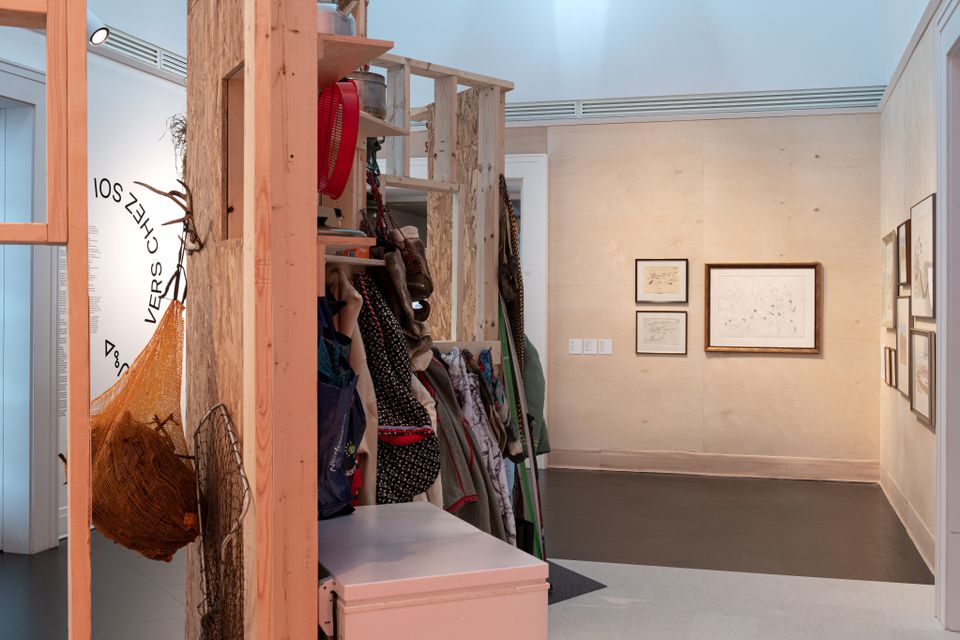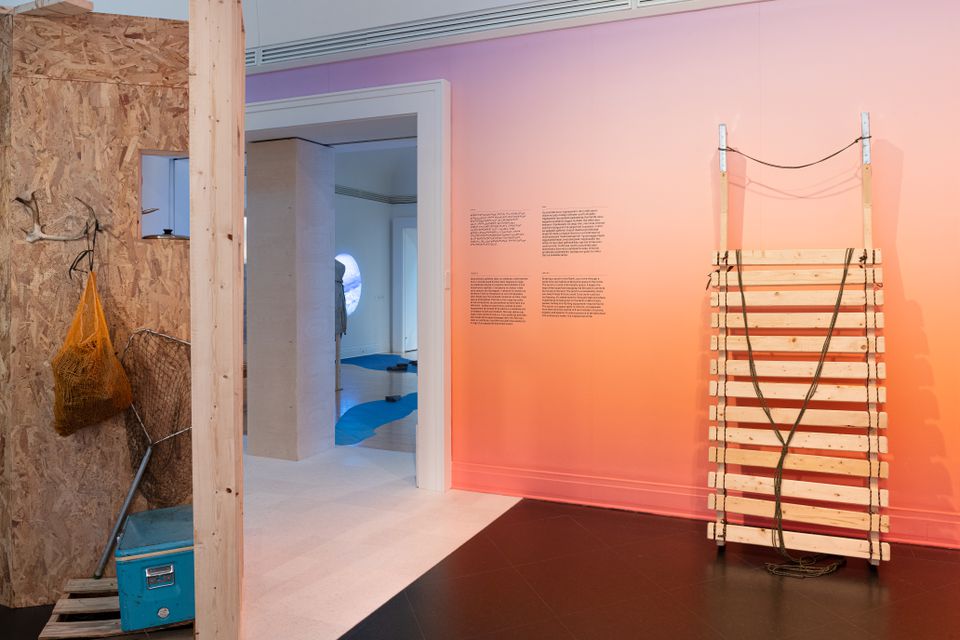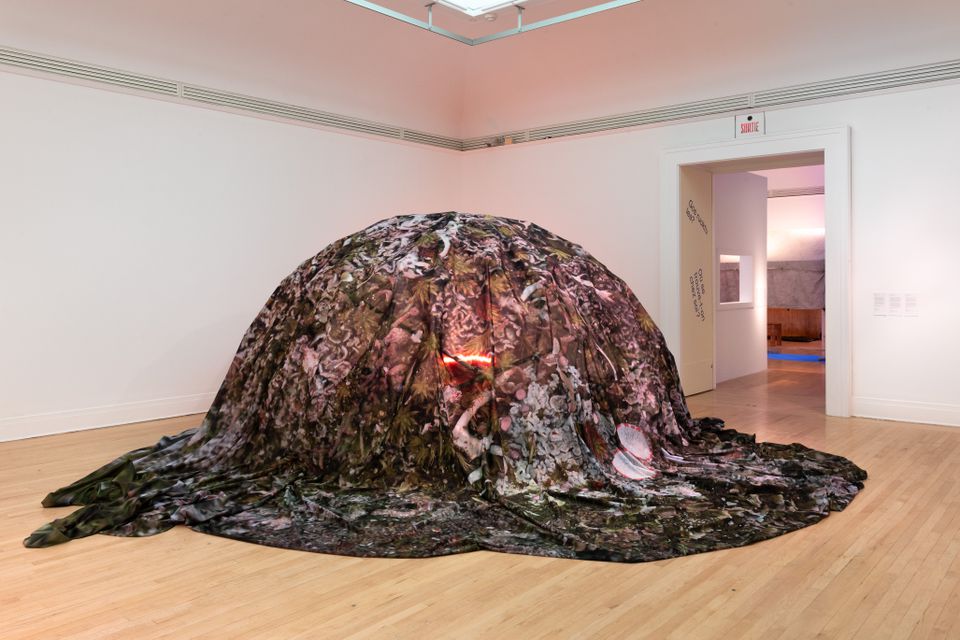Designing a Space for Home
Tiffany Shaw speaks with Rafico Ruiz and Ella den Elzen about in-between spaces, exhibition design, and connections to land
ᐊᖏᕐᕋᒧᑦ / Ruovttu Guvlui / Towards Home was co-curated by Joar Nango, Taqralik Partridge, Jocelyn Piirainen, and Rafico Ruiz, with Ella den Elzen as Curatorial Assistant. We have also published talks with artists Carola Grahn and Geronimo Inutiq. The exhibition is currently on view in our Main Galleries and runs until 12 February 2023.
- RR
- I’d like to start with a question that I’ve asked other collaborators involved in this project: What does angirramut, ruovttu guvlui, and towards home mean to you? I know you approach these languages from a different position than other members in the curatorial team.
- TS
- I’ve been trying to reflect on how the curators have come to the idea of what land means to them in relation to home. It was very clear for me when Taqralik [Partridge] was talking about forgotten, invisible, or throwaway spaces, because it really highlights the place that I think a lot of Indigenous people occupy but that other people do not see. I have also been thinking about this idea of giving people dignity in where they live and how they live in relation to home. These are questions that I’ve been keeping in the back of my mind; as people walk through the exhibition, how will it make them feel to connect to this landscape differently in relation to home?
One way that I’ve been trying to add to that language is through the idea of materials: things that Indigenous people in the North would see in their environment, to root themselves to this context. - RR
- Just speaking from your own position, once you come into the porch that stands at the entrance to the exhibition—what do you think you’re going to feel when you’re in that space for the first time?
- TS
- I’m not sure what I’ll feel when I see the porch, but what I’m interested to investigate is how materials come together, because what I think people often misjudge is how Indigenous people use these materials as a tool. I think that the porch is a tool for many things, on the inside and on the outside, which somehow relates again to Taqralik’s point about this forgotten or in-between space.
In Métis communities like the one my family comes from in Fort McMurray, the porch is also a transition space between inside and outside. So what I’m looking for to feel is this transition, where I’m ready to go out or I’m ready to go in: a feeling of expansion or contraction and having the tools that you need at your disposal, like warm boots or a warm jacket or a flashlight for different times of day. So I’ve been doing some research, like on the trapline for my family, about what these places look like. The outside portion of the house is where you put all the tools and all the items to do tanning or to fry fish and things like that, and so I feel like there is a similar understanding of space as in Inuit and Sámi communities. It’s not the same thing, but I feel there is a similarity of putting things where you need them and the idea that the clean aesthetic that you’ll find in magazines is not the point. The question for me was about the visualization of finding what you need, when you need it. It’s to be honest and truthful about how to make things useful.
- RR
- Is there a rationale behind the serrated or compressed line that drives the design of the exhibition porch? I know it was partly for this notion of compartmentalizing space.
- TS
- It came from a conversation with a graphic designer, Mark Bennett, about projection. And what I wanted to do was to create a confusion of space in a sense, by defining different axes and different pockets as a way to emphasize that connection between two different worlds.
- EdE
- Yes, I think that the way that it’s arranged in the space gives people that sense of compression, but also of entering into a new world or that kind of feeling that you and Taqralik kept describing. It really reorients them towards what the exhibition space is meant to be about.
- TS
- And I think that the sunrise represented on the wall is crucial, too. It’s like a notification of orientation as you come in, an anchor to pull yourself to as you move into the space. I’m trying to give you some level of comfort and safety and security through the sunrise. This first gallery as a whole is trying to disassemble and assemble how you are as a person in this transition space, which is a great architectural moment.
Jeffrey Kipnis talks about how when you enter a building there’s this “Aha” moment, but as you leave it, it’s a little bit flat. I think the porch structure helps solve this polarity. When you arrive to it, there is this moment of “What is happening in this space? Where do I move? How do I flow through?” The porch is not enclosed—you can walk around it—and even though we are using items that seem familiar, such as boots and jackets, it is meant to create a bit of discomfort.
I’m focusing on what your body feels as you move through the different spaces, and considering that you come from this very clean corridor space before you enter the exhibition—with this classical kind of character, because everything is well proportioned—the idea is to decentre you a little bit before you go into the next gallery, conceived by Geronimo Inutiq, which will decentre you even more.
- RR
- This notion of transition is key throughout the exhibition, especially with the different lighting conditions.
- TS
- Northern communities have largely been displaced, and there is supposed to be this dislocated feeling wherever you’re going in the exhibition and hopefully the objects root you to different feelings that are a bit unearthly. What isn’t physically present inside of the gallery is the reference to land—it’s the landscape that forms each community differently. So changing lighting conditions as you move between galleries is a way to generate that reference. I don’t know if people will notice the lighting changing in each of these spaces, but I’d like to at least think that it will matter for them again physiologically, like another anchor so that they can get into a sense of time of year that each artist is really exploring. And I tried my best to make it go in a full circle through the different seasons. That was my attempt.
What was really beautiful was understanding that up North there’s this conversation around seven seasons instead of four that we typically talk about. There’s the refinement on an early winter and a deep winter and things like that. And then also in some Sámi cultures they have eleven seasons that, if I understand correctly, revolve around the moon. I think that this refinement of seasonality is exactly the kind of conversation that most people can plug into if you are Indigenous because it’s how we move about the land.
I also like that each artist was able to tell me immediately what their favourite season was, and then describe the quality of light they liked in each season, which made me feel even more affirmed that this is the right notion to bring into this concept of home. Because that’s how you feel at home, when you think about things that you like or enjoy or love, also thinking about home in terms of safety. This exhibition for me is really about making Indigenous people feel comfortable moving through the space. That is the main priority that I have. My family doesn’t often go into galleries. I think about my parents a lot, or my grandma, or my cousins, and I want to find ways to make them feel that they are important in these spaces and that this is something that they recognize and is being talked about.
- RR
- I’m curious if you could describe what people would be looking at and feeling when they walk into the gallery with the installation by asinnajaq and you.
- TS
- Oh, I think asinnajaq would be much better to describe this, because her point of view is very particular to her family experience. I was trying to support how she came to the ideas in a physical way and with the structure itself. The concept that I understand that asinnajaq was exploring was around the idea of a home, a place to shelter you moving into different seasons. She was talking about two different layers: one to shelter you and your family and a secondary space that moves around it so that you can shift it as you need, like a temporary space where you can store your boots or some other kind of equipment. She’s thinking about the porch idea in another kind of utilitarian way that works really well with the land.
She also talked about how the landscape could move into the space, and we tried a few different devices in terms of the feeling you get by not describing something exactly. She asked a really beautiful question: “Have you ever slept in a bed of moss?” I would love to experience this at some point. She said that moss almost acts like memory foam, and that’s an experience that she wanted to bring to the seat inside the shelter. The bench itself is supposed to reference a slate-type rock that her family was cutting fish on, that they would feast on and then leave the remnants for the birds to come and pick up. She’s trying to reference this type of notion around community, family nourishment, and location in a bench, and that’s how we started to discuss what it should look like.
The structure itself is a reference to the igloo and is made out of wood dowels—we’ve been looking at Buckminster Fuller’s tensile structures—that create shapes similar to ice floes. And then she imagined a sheer or jersey fabric printed with images of moss or lichen that she photographed herself to lay over top of the structure, to create that second layer.
It’s almost like a dreamscape, because these spaces are not quite imaginable to me but they are very real for her. I feel like this conversation has been very much like a meeting of minds of how to make those experiences physical. We really tried to reference certain elements in the landscape that mean something to her, and I think that when people come into this space they will feel a certain lightness and a look to the future of how structures can occupy land or be occupied on land.
It’s interesting how this exhibition comes at the question of home through an artist lens rather than an architectural lens. The architectural conversation around Indigenous identity is still very poor, still lacking a lot of investment and reinforcement around the safety of these conversations, whereas the art-space conversation is much more advanced in Canada. I hope that people can understand that this is just one way of discussing northern identity around home and that there are many others.


